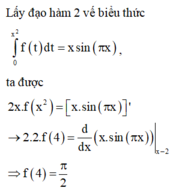Hãy nhập câu hỏi của bạn vào đây, nếu là tài khoản VIP, bạn sẽ được ưu tiên trả lời.

\(2x.f'\left(x\right)-f\left(x\right)=x^2\sqrt{x}.cosx\)
\(\Leftrightarrow\dfrac{1}{\sqrt{x}}.f'\left(x\right)-\dfrac{1}{2x\sqrt{x}}f\left(x\right)=x.cosx\)
\(\Leftrightarrow\left[\dfrac{f\left(x\right)}{\sqrt{x}}\right]'=x.cosx\)
Lấy nguyên hàm 2 vế:
\(\int\left[\dfrac{f\left(x\right)}{\sqrt{x}}\right]'dx=\int x.cosxdx\)
\(\Rightarrow\dfrac{f\left(x\right)}{\sqrt{x}}=x.sinx+cosx+C\)
\(\Rightarrow f\left(x\right)=x\sqrt{x}.sinx+\sqrt{x}.cosx+C.\sqrt{x}\)
Thay \(x=4\pi\)
\(\Rightarrow0=4\pi.\sqrt{4\pi}.sin\left(4\pi\right)+\sqrt{4\pi}.cos\left(4\pi\right)+C.\sqrt{4\pi}\)
\(\Rightarrow C=-1\)
\(\Rightarrow f\left(x\right)=x\sqrt{x}.sinx+\sqrt{x}.cosx-\sqrt{x}\)

Cho hàm số y=f(x)y=f(x) có đạo hàm và liên tục trên [0;π2][0;π2]thoả mãn f(x)=f′(x)−2cosxf(x)=f′(x)−2cosx. Biết f(π2)=1f(π2)=1, tính giá trị f(π3)f(π3)
A. √3+1/2 B. √3−1/2 C. 1−√3/2 D. 0

Đang học Lý mà thấy bài nguyên hàm hay hay nên nhảy vô luôn :b
\(I_1=\int\limits^1_0xf\left(x\right)dx\)
\(\left\{{}\begin{matrix}u=f\left(x\right)\\dv=xdx\end{matrix}\right.\Rightarrow\left\{{}\begin{matrix}du=f'\left(x\right)dx\\v=\dfrac{1}{2}x^2\end{matrix}\right.\)
\(\Rightarrow\int xf\left(x\right)dx=\dfrac{1}{2}x^2f\left(x\right)-\dfrac{1}{2}\int x^2f'\left(x\right)dx\)
\(\Rightarrow\int\limits^1_0xf\left(x\right)dx=\dfrac{1}{2}x^2|^1_0-\dfrac{1}{2}\int\limits^1_0x^2f'\left(x\right)dx=\dfrac{1}{5}\)
\(\Leftrightarrow\dfrac{1}{2}\int\limits^1_0\left[f'\left(x\right)\right]^2dx=\dfrac{3}{10}\Rightarrow\int\limits^1_0x^2f'\left(x\right)dx=\dfrac{3}{5}\)
Đoạn này hơi rối xíu, ông để ý kỹ nhé, nhận thấy ta có 2 dữ kiện đã biết, là: \(\int\limits^1_0\left[f'\left(x\right)\right]^2dx=\dfrac{9}{5}and\int\limits^1_0x^2f'\left(x\right)dx=\dfrac{3}{5}\) có gì đó liên quan đến hằng đẳng thức, nên ta sẽ sử dụng luôn
\(\int\limits^1_0\left[f'\left(x\right)+tx^2\right]^2dx=0\)
\(\Leftrightarrow\int\limits^1_0\left[f'\left(x\right)\right]^2dx+2t\int\limits^1_0x^2f'\left(x\right)dx+t^2\int\limits^1_0x^4dx=0\)
\(\Leftrightarrow\dfrac{9}{5}+\dfrac{6}{5}t+\dfrac{1}{5}t^2=0\) \(\left(\int\limits^1_0x^4dx=\dfrac{1}{5}x^5|^1_0=\dfrac{1}{5}\right)\)\(\)\(\Leftrightarrow t=-3\Rightarrow\int\limits^1_0\left[f'\left(x\right)-3x^2\right]^2dx=0\)
\(\Leftrightarrow f'\left(x\right)=3x^2\Leftrightarrow f\left(x\right)=x^3+C\)
\(\Rightarrow\int\limits^1_0f\left(x\right)dx=\int\limits^1_0x^3dx=\dfrac{1}{4}x^4|^1_0=\dfrac{1}{4}\)
P/s: Có gì ko hiểu hỏi mình nhé !

\(f'\left(x\right)=f'\left(1-x\right)\Rightarrow\int f'\left(x\right)dx=\int f'\left(1-x\right)dx\)
\(\Rightarrow f\left(x\right)=-f\left(1-x\right)+C\Rightarrow f\left(x\right)+f\left(1-x\right)=C\)
Thay \(x=0\Rightarrow f\left(0\right)+f\left(1\right)=C\Rightarrow C=42\)
\(\Rightarrow\int\limits^1_0\left[f\left(x\right)+f\left(1-x\right)\right]dx=\int\limits^1_042dx=42\)
Xét \(I=\int\limits^1_0f\left(1-x\right)dx\)
Đặt \(1-x=u\Rightarrow dx=-du;\left\{{}\begin{matrix}x=0\Rightarrow u=1\\x=1\Rightarrow u=0\end{matrix}\right.\)
\(\Rightarrow I=\int\limits^0_1f\left(u\right).\left(-du\right)=\int\limits^1_0f\left(u\right).du=\int\limits^1_0f\left(x\right)dx\)
\(\Rightarrow2\int\limits^1_0f\left(x\right)dx=42\Rightarrow\int\limits^1_0f\left(x\right)dx=21\)

Dạng: \(....f'\left(x\right)+...f\left(x\right)=...\)
Ý tưởng luôn là đưa về đạo hàm của tổng sau đó lấy nguyên hàm 2 vế.
Thêm bớt sao cho vế trái biến thành: \(u\left(x\right).f'\left(x\right)+u'\left(x\right).f\left(x\right)\) là được
So sánh nó với vế trái đề bài, dư ra \(u'\left(x\right)\) ở trước \(f\left(x\right)\) nên ta chia nó (vế kia vẫn ko quan tâm)
Được: \(\dfrac{u\left(x\right)}{u'\left(x\right)}.f'\left(x\right)+f\left(x\right)\)
So sánh nó với đề bài, vậy ta cần tìm hàm \(u\left(x\right)\) sao cho:
\(\dfrac{u\left(x\right)}{u'\left(x\right)}=x\left(x+1\right)\)
Nhưng để thế này ko lấy nguyên hàm được, phải nghịch đảo 2 vế:
\(\dfrac{u'\left(x\right)}{u\left(x\right)}=\dfrac{1}{x\left(x+1\right)}\)
Giờ thì lấy nguyên hàm: \(\int\dfrac{u'\left(x\right)}{u\left(x\right)}dx=\int\dfrac{dx}{x\left(x+1\right)}\Leftrightarrow ln\left|u\left(x\right)\right|=ln\left|\dfrac{x}{x+1}\right|+C\)
Tới đây suy được \(u\left(x\right)=\dfrac{x}{x+1}\) \(\Rightarrow\) vế trái cần có dạng:
\(\dfrac{x}{x+1}f'\left(x\right)+\dfrac{1}{\left(x+1\right)^2}f\left(x\right)\)
Nhìn vào đây là xong rồi. Bài toán sẽ được giải như sau:
Chia 2 vế giả thiết cho \(\left(x+1\right)^2\):
\(\Rightarrow\dfrac{x}{x+1}f'\left(x\right)+\dfrac{1}{\left(x+1\right)^2}f\left(x\right)=\dfrac{x}{x+1}\)
\(\Leftrightarrow\left(\dfrac{x}{x+1}+f\left(x\right)\right)'=\dfrac{x}{x+1}\)
Lấy nguyên hàm 2 vế:
\(\Rightarrow\dfrac{x}{x+1}+f\left(x\right)=\int\dfrac{x}{x+1}dx=\int\left(1-\dfrac{1}{x+1}\right)dx=x-ln\left|x+1\right|+C\)
\(\Rightarrow f\left(x\right)=x-\dfrac{x}{x+1}-ln\left|x+1\right|+C=\dfrac{x^2}{x+1}-ln\left|x+1\right|+C\)
Thay \(x=1\)
\(\Rightarrow f\left(1\right)=\dfrac{1}{2}-ln2+C\Rightarrow-2ln2=\dfrac{1}{2}-ln2+C\)
\(\Rightarrow C=-ln2-\dfrac{1}{2}\)
\(\Rightarrow f\left(x\right)=\dfrac{x^2}{x+1}-ln\left|x+1\right|-ln2-\dfrac{1}{2}\)
\(\Rightarrow f\left(2\right)=...\)





đặt :
\(F\left(x\right)=\int_0^{x^2}f\left(t\right)dt=xsin\left(\pi x\right)\Leftrightarrow F\left(x^2\right)-F\left(0\right)=xsin\)
\(\left(\pi x\right)\Leftrightarrow F\left(x^2\right)=F\left(0\right)+xsin\left(\pi x\right)\)
lấy đạo hàm \(2\) vế , ta có :
\(\left(F\left(0\right)\right)'=sin\left(\pi x\right)+\pi xcos\left(\pi x\right)+\left(F\left(0\right)\right)'\)
\(\Leftrightarrow2xf\left(x^2\right)=sin\left(\pi x\right)+\pi xcos\left(\pi x\right)\)
thay \(x=2\) , ta có :
\(2.2.f\left(4\right)=sin\left(2\pi\right)+2\pi cos\left(2\pi\right)\Leftrightarrow4f\left(4\right)=2\pi\Leftrightarrow f\left(4\right)=\dfrac{\pi}{2}\)